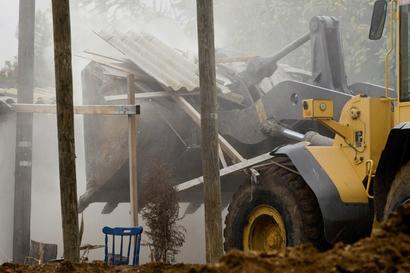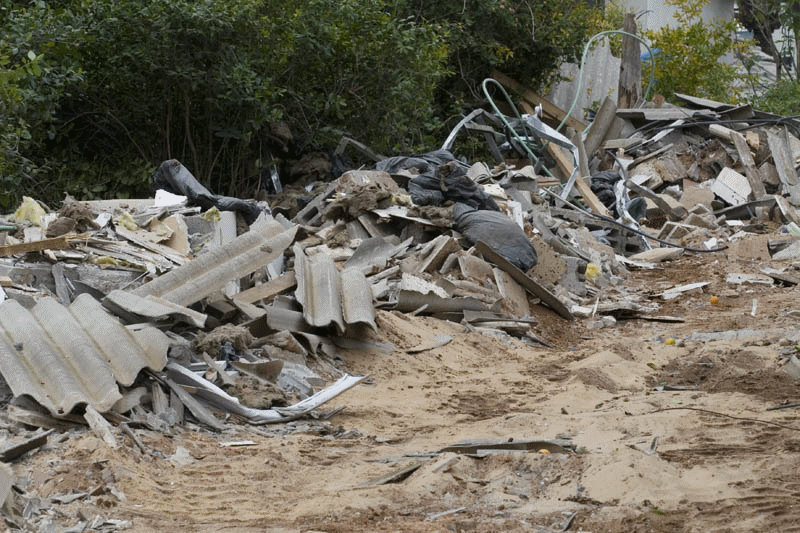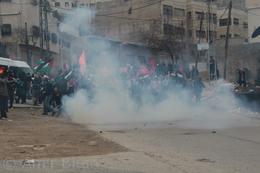
In the morning hours of 25 December 2007, agents of Israel’s judicial execution office backed up by a force of hundreds of police, evicted about twenty-five families from the “Mahal/Moshe Dayan” compound situated in the southwest corner of Kfar Shalem (in southern Tel-Aviv). Unprecedented in the history of evictions carried out at Kfar Shalem, this time the evictees, the longest residing families of the compound, having lived in their homes since 1948-1949, did not receive any compensation before their eviction.
Within a few hours most of the buildings were destroyed. A place where, for decades, there had been houses, courtyards, walkways, paved areas, potted plants, vines, and gardens was suddenly transformed into an “empty lot.” A row of houses running long the southern perimeter of the compound, in an area owned by the Israel Lands Administration (ILA), was left standing, for now. Another small house, standing alone in a municipally-owned lot, also remains, for the meantime. Yet another old house that was left standing is the original, abandoned Arab building that was occupied by the grandmothers of today’s evictees in the winter of 1948-1949, just 59 years ago. Amidar (a state-owned housing company) had no choice but to recognize the rights of its inhabitants, who have regularly kept up with the monthly rental payments to the company.
During the past few months we have taken part in the activities of the residents in support of their struggle against attempts to dispossess them from their homes. The point of departure from which the organized public struggle began was a difficult one: from a legal perspective, the dispossession had been virtually finalized years ago. An investor named Roma Efrati, who has never actually lived in the area, is the government land registry’s certified owner of about an acre of very centrally-located land in the compound. On this property, three large Yemenite-Jewish families, who arrived shortly after the removal of the residents of the Palestinian village Salameh, set up residence for themselves in structures adjacent to the original main residential building (today known as the “Arab House”), structures that had previously served as a pen for sheep and goats, warehouses, and chicken coops. During the 1950’s and 60’s, always with the full consent of the authorities in charge, first the Jewish Agency and later other offices, these structures were expanded and transformed into true domestic residences in every sense of the word. Apparently, during the early 1990’s, Ms. Efrati acquired ownership of this acre of land after it — how and why is still not entirely clear — had remained private land, never having been transferred to the guardianship of the Israel Lands Administration, as had most of the land in Salameh/Kfar Shalem within a few years after the founding of the state of Israel.

For years the inhabitants of these lots resided on them, never aware of the legal status of the land, nor of any difference between its status and that of adjacent lots. It is precisely this difference that has achieved new significance in the present-day legal environment, when private property rights, especially the right to exercise full ownership rights, are recognized as fundamental rights, having preference over those granted to non-owning residents of previously unoccupied land. In the past, various authorities, including the courts, tended to accept as obvious the assumption that the eviction of long-time residents, even those who had resided on land privately-owned by others, makes mandatory an agreement for compensation, or in other words, the act of eviction by necessity involves negotiation and compensation. Today, the common judicial approach distinguishes between matters of eviction and compensation. In more than one legal decision made with regard to Kfar Shalem and other locales, it has been ruled in a variety of manners that the residents are first obliged to evacuate their premises, and only afterwards will a discussion of compensation begin; a discussion that will recognize no inherent connection to the act of eviction itself. Generally, the residents — for the most part poor — are thrown out of their homes, and are thereby left with no bargaining power against real estate magnates, capital investors, and governmental authorities. With no legally recognized conditionality between eviction and compensation, the evictees have no significant leverage in their struggle to receive just and appropriate compensation.
Under the circumstances that have thus evolved, only a broad-based, public campaign can give the evicted residents the tools to conduct an effective fight against the private interests who have neither offered them compensation nor even agreed to enter into negotiations with them. For the residents of the “Mahal/Moshe Dayan” compound who were evicted yesterday, the main lever in achieving such compensation is the Tel-Aviv municipality. Obviously, the main goal of the property owner, or whoever is behind her, is to undertake the construction of high-rise buildings on the site. Real estate prices for land and apartments in Tel-Aviv are sky-high. It is the Tel-Aviv municipality that has the power to make the issuing of building permits and any overall cooperation with development plans for a given project on the site, conditional upon the achieving of an appropriate compensation agreement with the evicted residents.
For this reason, immediate public pressure should be directed to the municipality. Its conduct during this entire episode has been disgraceful, but this simply reflects its anti-social attitude under the leadership of Ron Huldai, the current mayor. Deputy Mayor Arnon Giladi lives about 300 meters from the site, in one of the most luxurious buildings in the neighborhood, constructed in recent years. During all the months that the struggle for the “Machal/Moshe Dayan” compound was going on, Giladi didn’t even bother to come to one of the protest events organized by the residents. He also rejected their appeals for his intervention, and tried to avoid the issue by means of bureaucratic excuses, more appropriate to some minor city official, but not to one elected to office. Only last Friday, when dozens of residents of the compound spontaneously decided to stage a protest rally with megaphones outside his home, did he agree to come down and speak with them, but did not commit himself to taking any significant step. The only result of that demonstration was a demagogic speech delivered by Giladi during a City Council meeting, in which he argued that an injustice had been perpetrated on the long-time residents, but again, didn’t offer any real solution or means of intervention by the municipality.
On the city-wide level, an awakening of neighborhood activists is taking place in southern Tel-Aviv and Jaffa against the Huldai’s efforts to turn Tel-Aviv into a kind of Manhattan, a city of high-rise buildings constructed with the aim of rapidly enriching real estate sharks and deal-makers well-connected to the municipal establishment. While the seaside neighborhoods and city center are being emptied of poor and middle class residents for the benefit of buyers from abroad and the local rich, in the southern part of the city, long-time and poorer residents are beginning to be forced out, and high-rise apartments are being built for the middle class. This is a gradual but very tangible process.
Note should be made of the importance of the solidarity and increasing cooperation between the neighborhoods. At Sunday’s protest rally outside the City Council meeting, along with residents from Kfar Shalem were participants from a number of other poor Tel-Aviv neighborhoods: Argazim, Ezra, Neve Shaanan, and Florentine. Activists from the Popular Committee of Jaffa, who are fighting eviction and demolition orders issued against Arab residents from that part of the city, have visited Kfar Shalem a number of times and have even lent them the Protest Tent which has become a focal point in which evictees gather together with activists from other compounds in Kfar Shalem.
On a more general level, the events at Kfar Shalem should be understood as part of a larger, ongoing process in which the neo-liberal state increasingly renounces any significant responsibility towards its own citizens by instituting an all-pervasive process of privatization. More and more, the state is functioning primarily as the executive arm of a small group of ultra-wealthy. This elite’s all-too-familiar racism finds expression in its depiction of the Yemenite-Jewish residents of Kfar Shalem as criminals and liars. This starts with police raids conducted in the middle of the night, during which neighborhood youths are arrested for no real reason and are held for questioning, after which the events are reported in the media as being somehow criminally-related. At 2 a.m. on the night before the eviction, when camped out at the site with local activists, we witnessed such a police raid. The humiliating treatment of the young men of the compound as criminals, unwarranted by any real actions on their part, was intended to both break their spirit and to influence public opinion in support of the evictions. In the meantime, the lives of these young people may be ruined.
The efforts to criminalize the public image of the residents of Kfar Shalem was furthered by spokespersons like Menachem Leibe, General Manager of the Tel-Aviv municipality, who, in an interview with I.D.F. Radio, intentionally lied, denying the long-term residency of the families living in Kfar Shalem, and depicted them as recent intruders. “Intruders” is a code word whose use is designed to give listeners unfamiliar with the case the impression that those involved are persons not worthy of protection or even of serious consideration of their claims. The term “intruders” has a long tradition in establishment racism in Israel. For the establishment, “intruders” or “criminals” are always Bedouin, Arabs, Oriental Jews, or the poor in general. Have you ever heard of a large construction company that deviated from its authorized building site and thereby earned the title “intruder”? At the very most, the authorities refer to “construction without permits,” but not to “criminal construction companies.” Have you ever heard of “intruding” or “unlawful builders” in connection with deviations from authorized construction or deviations from permitted use in affluent areas like northern Tel-Aviv, kibbutzim, in Herzliya Pituach, or Ramat HaSharon? Even West Bank settlers living in illegal strongholds are never labeled as “criminals” or “intruders” by government spokespersons. Just as with Israel’s Arab population, in Kfar Shalem the government, municipality, and authorities in general found no reason to implement the same mechanism for negotiations in consideration of the residents’ needs that is always automatically invoked for those segments of the population that are well-connected to the political establishment and the social elites.
“Intruders” are always the evicted, the former residents. The evictors — those who come and throw people out of their homes for profit — are never “intruders.” They are “settlers” when this happens in outlying areas at the expense of Arabs (like the isolated ranchers authorized to settle in the Negev), or “real estate investors,” or “entrepreneurs.”
The neighborhood residents, who during the 1980’s and 90’s still had a certain amount of patronage in the center of political power, patrons who would intervene on their behalf and achieve something for them or at least soften the blows, these residents have been abandoned by the politicians. The latter cannot or do not want to truly represent the residents in their struggle against the processes of privatization. Lobbying cannot really help any more, and thus the politicians and lobbyists loose their relevance. From now on, what is needed are more determined struggles based on significant resistance to both dispossession and continued deprivation. The time of the deal-makers entrenched in the establishment is coming to an end. Instead, these will be increasingly replaced by devoted popular leaders and activists, committed to the residents based an understanding that nothing will be achieved without a struggle.
These words are really only an interim summary and update. The evicted are in need encouragement to continue their struggle for compensation. Therefore, coordinating visits to the Protest Tent next to the compound is a worthy undertaking (contact David at 057-2503124). In Kfar Shalem, in compounds similar to “Mahal/Moshe Dayan,” there are hundreds of other families living under a variety of legal statuses. During the past few months, most of these families have been served eviction notices. The struggle has not ended, first of all because the residents of the “Mahal/Moshe Dayan” compound are entitled to solutions and compensation, but also because this struggle has broad implications for all other similar struggles and for the rights of all the residents of the neighborhoods of southern Tel-Aviv and Jaffa, and for the treatment of simple citizens who have little money and less political power. Undoubtedly, in the coming days, additional protest activities will be announced by the Kfar Shalem Committee and the South Tel-Aviv Neighborhood Forum. The struggle, in its broader sense, is just starting.


